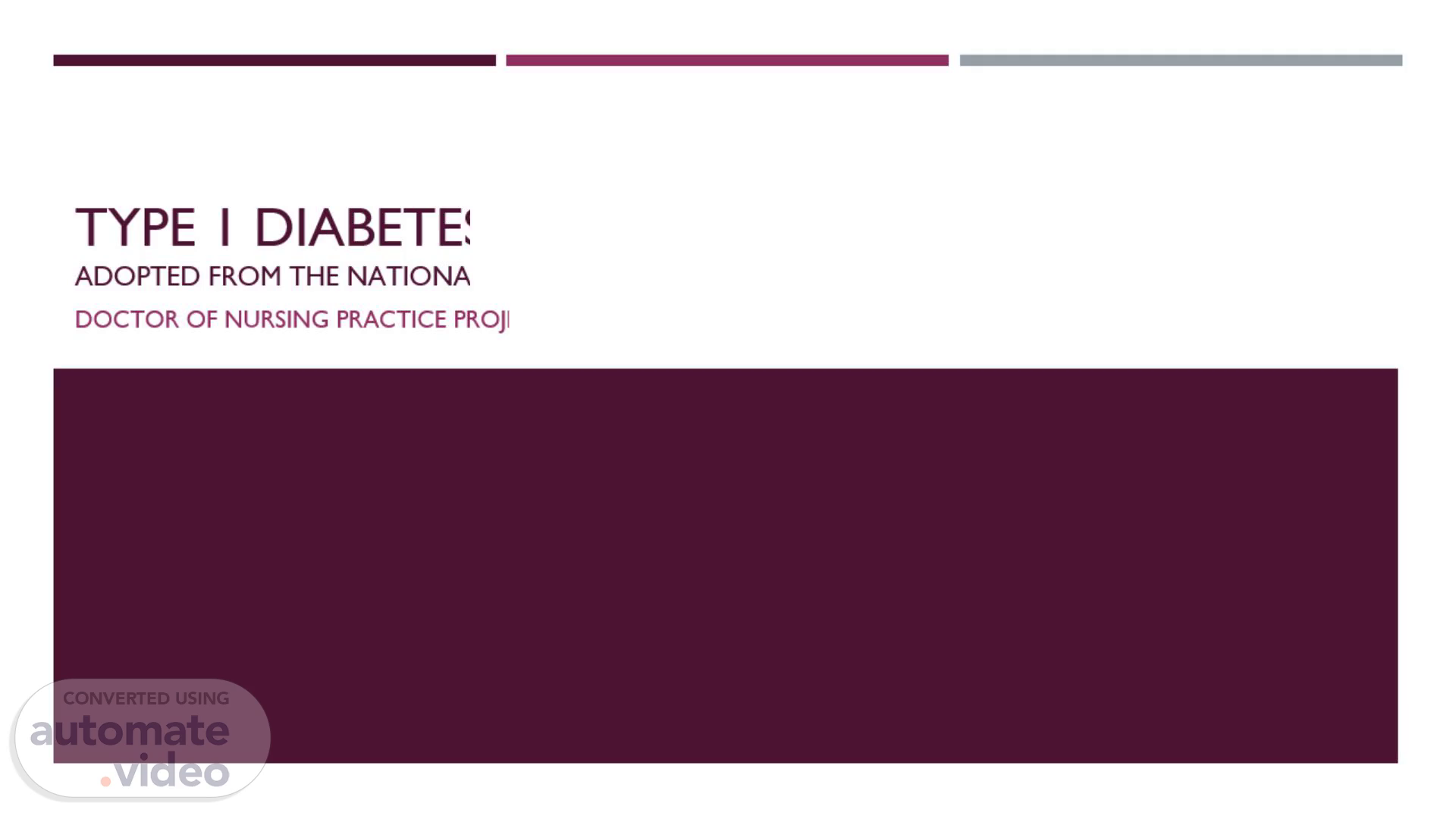
Page 1 (0s)
Type 1 Diabetes for Teachers adopted from the National Association of School Nurses Diabetes toolkit (2022).
Page 2 (10s)
Table of Contents. Discloser Purpose Definitions Type 1 Diabetes Insulin Blood Glucose Monitoring Target Blood Levels Hyperglycemia Treating Hyperglycemia Hypoglycemia Treating mild to moderate hypoglycemia Treating severe hypoglycemia The needs of students with T1DM Accommodations.
Page 3 (22s)
Discloser. As an educator, it is essential to have a good understanding of Type 1 Diabetes Mellitus (T1DM) and how it may impact a student's daily life. This educational PowerPoint is designed to help teachers gain knowledge about T1DM and how to respond in an effective and confident manner when educating a student with T1DM. It is important to note that each student with this medical diagnosis will have a provider order that explains how to manage their diabetes. It is crucial that these instructions are followed, and this PowerPoint can serve as a valuable tool to understand the procedures better..
Page 4 (48s)
Purpose. Provide all teachers with general information about Type 1 Diabetes (T1DM) Educate on the “target range”. Provide education on how to recognize and respond to diabetes emergencies. Gain an awareness of the particular needs of students with T1DM and how to meet those needs. Provide tools that outline the key roles and responsibilities of all personnel in the school..
Page 5 (1m 6s)
Definitions. Blood Glucose Often known as blood sugar, it is the primary source of the body’s energy. The term glucose levels may be used with the innovation of interstitial sensor glucose readings. It can also be assessed with a glucose meter by a drop of blood from the finger. Continuous Glucose Monitor (CGM) A wearable device inserted under the skin measures glucose levels and continuously collects data. This data is then sent to a monitor or mobile device for real-time monitoring and sharing with the healthcare team and family. It empowers patients to regulate and balance their food, medication, and physical activity, ensuring prompt prevention and treatment of hypo and hyperglycemia..
Page 6 (1m 49s)
Type 1 Diabetes. It is an autoimmune disease The body no longer produces insulin It has no known cure Can affect children Symptoms of diabetes include frequent urination, fatigue, and sudden weight loss. A delay in diagnosis can lead to life-threatening events. Requires 24/7 management to balance insulin administration with daily living.
Page 7 (2m 10s)
Insulin. It is naturally produced in the body by the pancreas. Students with T1DM need the administration of insulin throughout the school day. The type and how often are ordered by the healthcare provider. Can be delivered by: Syringe Pen Pump Its function is to bring the glucose level down in the body..
Page 8 (2m 33s)
Blood Glucose Monitoring. An important tool in managing T1DM It can be a Glucometer or a Continuous Glucose Monitor (CGM) Used at the healthcare provider prescribed the frequency and when the student is experiencing symptoms..
Page 9 (2m 52s)
Target Blood Levels. [image] Content Placeholder 6.
Page 10 (3m 4s)
Hyperglycemia. It can become an emergency. It is often found in uncontrolled or undiagnosed diabetes Can occur when: There is a lack of insulin To much food Low activity Stress or Illness.
Page 11 (3m 26s)
Treating Hyperglycemia. Notify School Nurse Assist the student to the Nurse’s Office to allow for the administration of insulin if prescribed. Extra Liquids Bathroom Access Light Activity The nurse will notify the family and/or emergency medical services..
Page 12 (3m 43s)
Hypoglycemia. Medical emergency and greatest danger for a student with T1DM Occurs with: Too much activity Too much insulin Not enough food Frequently occurs: Before lunch End of Day During or after physical education.
Page 13 (4m 9s)
Treating Mild to Moderate Hypoglycemia. Treat with or without a nurse present if experiencing symptoms. Provide: Fast-Acting sugar Glucose Tablets 4oz of fruit juice 4-6oz of soda Stay with the student and assist them to the nurse's office with an adult. Never alone..
Page 14 (4m 27s)
Treating severe hypoglycemia. This is a medical emergency Act immediately Stay with student Lay student down Do not provide any oral treatment if the student is unable to follow directions or speak, Contact school nurse.
Page 15 (4m 43s)
The needs of Students with T1DM. Developmental Issues Care depends on self-management Self-management ability differs by age Preschool- age: needs support Elementary-age: can perform tasks with supervision Middle- and High school-age: level of self-care varies In emergency situations, all students will need assistance..
Page 16 (5m 8s)
Accommodations. Some accommodations but not limited to:.
Page 17 (5m 25s)
Summary. T1DM is a chronic autoimmune disease Insulin and blood glucose monitoring is imperative. The goal of care is to ‘stay in range.’ Recognize and respond to hypo and hyperglycemia appropriately. Know your role and responsibilities..
Page 18 (5m 39s)
References. Chatzistougianni, P., Tsotridou, E., Dimitriadou, M., & Christoforidis, A. (2020). Level of knowledge and evaluation of perceptions regarding pediatric diabetes among greek teachers. Diabetes Research and Clinical Practice, 159, 107952. Retrieved June 6, 2023, from https://doi.org/10.1016/j.diabres.2019.107952 National Association of School Nurses. (2022, August 5). Students with type 1 diabetes toolkit [PDF Document]. https://www.nasn.org/blogs/nasn-inc/2022/08/05/students-with-type-1-diabetes-toolkit..